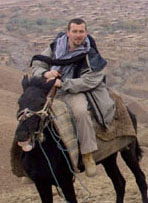I was fairly certain there would be no other news photos of this important scene as guards had sealed off the back entrance. My images were also digital – which had only recently become the standard format among news photographers and editors. As such, it would be possible to distribute them to many different editors, I realized, and therefore maximize their value. I phoned the photo editors that I knew at major daily newspapers in London and New York. They all wanted to see my photographs for the same-day news cycle. However, the challenge was getting them there because the slow and unstable phone connections couldn't handle the large photo files. I spent hours frantically trying to email my images to these clients without success. In desperation, a friend in London agreed to let me upload my images to his personal Web site, from where they could be emailed or downloaded to the editors. This simplified everything, and by the end of the day I had sold my pictures to newspapers in the United States and United Kingdom, including the Boston Globe, the Atlanta Journal-Constitution, the LA Times, the Daily Mail, and the Sunday Times of London. Despite this success, I knew that my images had not reached their full sales potential in the new digital marketplace. In the following days and weeks, I began offering this distribution channel to other freelance photographers in Kosovo. For example, a French photographer sold his images to newspapers and magazines in France, Belgium, and Switzerland. An Israeli photographer sent images to editors at home and in Asia. Soon, a small group of us were sharing resources, using this simple system to sell our images to a widening circle of editors in nearly a dozen countries. We had created a small-scale platform for independent photographers to distribute images directly to clients – something they could not efficiently do on their own. After leaving Kosovo, I realized that this model solved a number of problems for both photo editors and photographers. Editors on deadline could get images earlier in the day, increasing their options and reducing their last minute reliance on wire service photos. Photographers could vastly increase their sales potential through worldwide distribution, while keeping copyright and control of their images, which are lost when photographers deal with traditional agencies and wire services. Today, my original idea has evolved into World Picture News (WpN) – a central electronic marketplace designed to link thousands of independent photographers with photo editors at publications in every market worldwide. We launched the company in September 2001, and have experienced positive growth through our proof-of-concept stage, raising over $200,000 in revenue in our first six months of operation. Besides distributing images for scores of photographers, we have gained sole rights to distribute the stunning photos taken by the Revolutionary Association of the Women of Afghanistan (RAWA), resulting in a profit-sharing model for working with other image-generating organizations in the future. Today, we are starting the process of raising venture capital, aggressively expanding our network of participating photo editors and independent photographers, and are upgrading our technology to provide a robust, scalable platform to support the growth of this marketplace. © Seamus Conlan |
|
|
Write a Letter
to the Editor |
